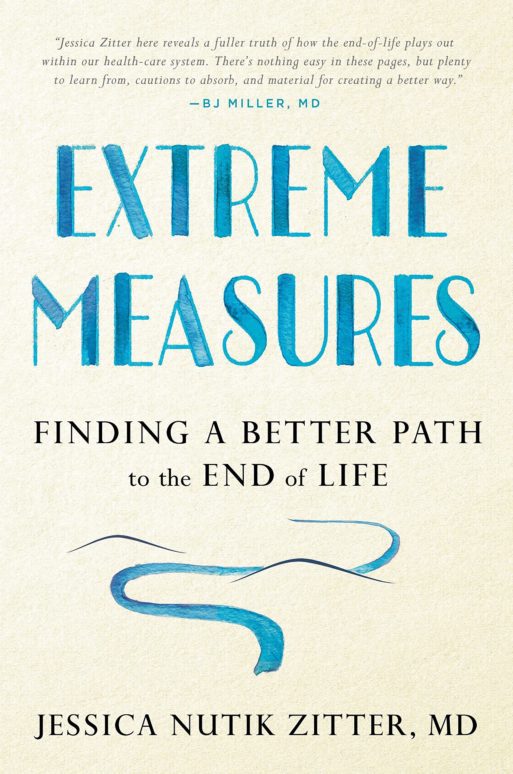 “Extreme Measures: Finding a Better Path to the End of Life” by Jessica Nutik-Zitter, M.D. is a book about America’s extraordinarily dysfunctional relationship with death. It is also, in many ways, a deeply personal memoir — a chronicle of an exceptionally bright and talented young doctor’s journey through the medical education system, from medical student to resident to attending physician in the ICU. And, perhaps most of all, it is a heartbreaking portrayal of what the author so aptly calls the “end-of-life conveyor belt” — the invisible mechanism of the ICU that catapults thousands of unwitting patients towards a lonely, painful, medicalized death.
“Extreme Measures: Finding a Better Path to the End of Life” by Jessica Nutik-Zitter, M.D. is a book about America’s extraordinarily dysfunctional relationship with death. It is also, in many ways, a deeply personal memoir — a chronicle of an exceptionally bright and talented young doctor’s journey through the medical education system, from medical student to resident to attending physician in the ICU. And, perhaps most of all, it is a heartbreaking portrayal of what the author so aptly calls the “end-of-life conveyor belt” — the invisible mechanism of the ICU that catapults thousands of unwitting patients towards a lonely, painful, medicalized death.
Jessica Nutik-Zitter is a rarity in the medical world. Trained in pulmonary and critical care medicine, she began her career as an ICU physician — an “intensivist” whose goal was to keep the sickest of the sick alive at any cost. Yet even as a young resident, she had serious misgivings about the nature of her work.
In one of the early chapters of the book, she describes her first “Code Blue.” Running into the patient’s room, heart pounding, finally on the cusp of “saving a life,” she encountered the inert body of a frail, elderly man being set upon by a group of doctors, frantically pounding on his chest and using electric shocks to try to jump start his heart. She describes the sickening sound of cracking ribs as they administered CPR, and her profound dismay when she realized she and her colleagues were trying to revive a corpse. It was, she says, the first in a series of deeply disturbing experiences that shaped her values as a physician and the rest of her career.
Today, Dr. Zitter is board certified in two seemingly disparate specialties: critical care and palliative medicine and hospice care. She divides her time in the hospital equally between the two roles. But her goal as a physician is to bring the two specialties together under the overarching umbrella of holistic, patient-centered care — a philosophy that puts patient values and goals ahead of prolonging life at any cost. It’s that philosophy, she believes, that will put a stop to the end-of-life conveyor belt and give dying people and their families the freedom to choose a peaceful, natural death.
But the journey won’t be easy, she freely admits. Beginning with America’s “more is better” attitude and our collective delusion that death is something we can actually avoid, “Extreme Measures” details the many obstacles that stand in the way of “a good death.” The medical establishment is, of course, one. Doctors are indoctrinated into the belief that death is the enemy and that it is unethical and perhaps immoral to give up the fight until every weapon in their arsenal of machines and medicines has been used. But patients and their surrogates contribute nearly as much by avoiding the kind of frank, honest discussions about death that could stop the conveyor belt in its tracks. Culture, personal values and even race also play important roles.

Dr. Jessica-Nutik Zitter
“Extreme Measures” is an extremely compelling read — a deep dive into the hidden world of intensive care medicine and the often tragic results of our cultural avoidance of death. Dr. Zitter includes dozens of moving accounts of people stuck on the end-of-life conveyor belt — tethered to machines, tubes in every orifice, surrounded by doctors who are trained to pay attention to numbers and lab values rather than human beings and their needs. Many of these stories are tragic and difficult to read. And far too many of them end with the patient dying in the ICU or being transferred to a long-term care facility, attached to a breathing machine for the rest of their lives.
Occasionally, however, there are good outcomes. After meeting with the palliative care team, a woman with advanced ovarian cancer is able go home to her family in Guatemala after making a difficult decision to pursue surgery along with comfort care. A young man’s family comes to grips with the futility of continued efforts to save his life and agrees to remove his breathing tube so he can die a natural death. A grandmother with end-stage cancer leaves the ICU and spends several months at home with her family before she dies. But these victories seem far too few, and the battles that made them happen seem far too hard.
In the end, however, “Extreme Measures” provides a measure of hope — a glimpse into a future when doctors and patients will no longer feel compelled to use technology to prolong life at any cost. Attitudes are shifting, Dr. Zitter assures us. The institution of medicine is beginning, albeit slowly, to bridge the divide between doctors who do to their patients and those who work with their patients to identify goals of care. Communication, she says again and again, is the key to finding and eventually expanding a middle ground.
“Extreme Measures” is an extraordinary introduction to the grim realities of the American way of death. It’s my hope that it also serves as inspiration to those who read it; that it helps us acknowledge that there is a better path to the end of life, and that it begins with each of us.

 ”Extreme Measures” by Jessica Nutik-Zitter, M.D.
”Extreme Measures” by Jessica Nutik-Zitter, M.D.


 Neil deGrasse Tyson Prompts Ruminations on Life & Death
Neil deGrasse Tyson Prompts Ruminations on Life & Death
 “I Will Remember You” by Sarah McLachlan
“I Will Remember You” by Sarah McLachlan
 Greenland Sharks May Offer Clues to Extending Human Lifespans
Greenland Sharks May Offer Clues to Extending Human Lifespans














